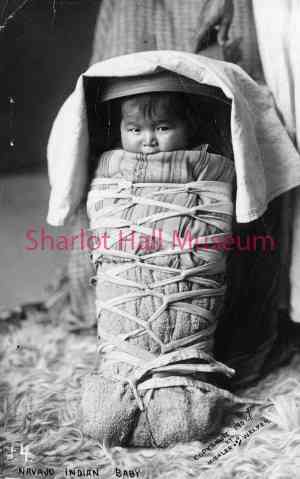Navajo Baby in a Cradleboard
details
Mishler and Walker, Photographers Unknown inn815p.jpg IN-N-815 B&W 1504-0815-0000 inn815p Postcard 3x5 Historic Photographs 1908 Reproduction requires permission. Digital images property of SHM Library & ArchivesDescription
Navajo cradleboards are made with a Ponderosa pine frame with buckskin laces looped through the frame. Whatever materials are used to make cradleboards, they share certain structural elements. Cradleboards are built with a broad, firm protective frame for the infant's spine.
The back board signifies Mother Earth or Nahasdzaan, while the left board signifies Father Sky or Ya dilhil. The two boards are laced as one with buckskin, the upper end of the board is engraved to form a V-shape. Close to this V-shape are two tiny holes which signify Ears or Jeeyi’.
There is an oak that is thinly cut so as to twist into a bow and is linked close to the top. This signifies rainbow or Naatsi iilid, and gives security for the child’s head. There are loops made of buckskins attached to the sides of the board that represent Lighting or Atsiniltl’ish. On the right part of the board is a long buckskin tie that is utilized to tie these loops and lace the infant. This signifies Sun Beam or shabitl ool.
There is a wood situated at the base of the board that serves as a foot rest which signifys small rainbow or Naats iilid.
The infant is positioned on a mantle in the cradle board. The arms are put down at the sides, and then the mantle is folded warmly around the infant. Then the buckskin tie is drawn in the side loop, criss-crossing the whole body of the infant, fastening it safely into the cradle board. A cloth of buckskin can then be place on the top to secure the infant from UV rays and from insects as well.
(Source: https://navajocodetalkers.org/navajo-cradleboard-story/)
The postcard was mailed to Miss Sharlott M. Hall with a poststamp of July 23, 1913, from Kingman, Arizona.
Purchase
To purchase this image please click on the NOTIFY US button and we will contact you with details
The process for online purchase of usage rights to this digital image is under development. To order this image, CLICK HERE to send an email request for details. Refer to the ‘Usage Terms & Conditions’ page for specific information. A signed “Permission for Use” contract must be completed and returned. Written permission from Sharlot Hall Museum is required to publish, display, or reproduce in any form whatsoever, including all types of electronic media including, but not limited to online sources, websites, Facebook Twitter, or eBooks. Digital files of images, text, sound or audio/visual recordings, or moving images remain the property of Sharlot Hall Museum, and may not be copied, modified, redistributed, resold nor deposited with another institution. Sharlot Hall Museum reserves the right to refuse reproduction of any of its materials, and to impose such conditions as it may deem appropriate. For certain scenarios, the price for personal usage of the digital content is minimal; CLICK HERE to download the specific form for personal usage. For additional information, contact the Museum Library & Archives at 928-445-3122 ext. 14 or email: orderdesk@sharlot.org.




